Southampton has a rich history of producing promising talents, some of whom have gone on to become great players. Look no further than Alan Shearer and Gareth Bale. The likes of Luke Shaw, Theo Walcott, Adam Lallana, and Alex Oxlade-Chamberlain are just a few of the recent prominent former academy graduates who have played for some of the top-tier clubs in Europe.
For the first time since the Ronald Koeman era, a sense of optimism regarding the academy has been reinstated at the club under the management of Ralph Hasenhüttl. While the ex-RB Leipzig manager has already handed first-team debuts to the likes of Nathan Tella, Jan Valery, Jake Vokins, and Michael Obafemi, one name that has impressed the most is Will Smallbone.
This tactical analysis in the form of a scout report intends to analyze Smallbone’s strengths and playing style that makes him a special talent. We will also highlight the aspects that the youngster needs to work on to make the next big step.
Player Profile
Born in England, the Irish international had joined the Saints at the age of eight. After progressing through the youth ranks, the youngster became a permanent name in the U23 side over a year ago before getting a call-up to the senior team on 4th January 2020 to face Huddersfield Town in the FA Cup third-round tie.
After scoring on debut and following it up with a man of the match performance in his Premier League debut against Aston Villa, the 20-year old eventually went on to win the club’s Young First-team Player of the Season award.
Standing at 173 cm. and 61 kgs, Smallbone is not the most physical player. However, the 20-year old has a good body balance which makes it difficult for an opposition to take him down easily. Although physicality is not his strength, the youngster has a very calm and composed demeanor which is a great asset on and off the ball. While it allows the Irishman to pick out a right pass during the possession, it also helps the youngster to stay on the ground without easily going down and harrying into a tackle when not in possession.
Style of play & role in Hasenhüttl’s tactics
To understand the playing style of Smallbone, consider the following heatmap of his previous season.
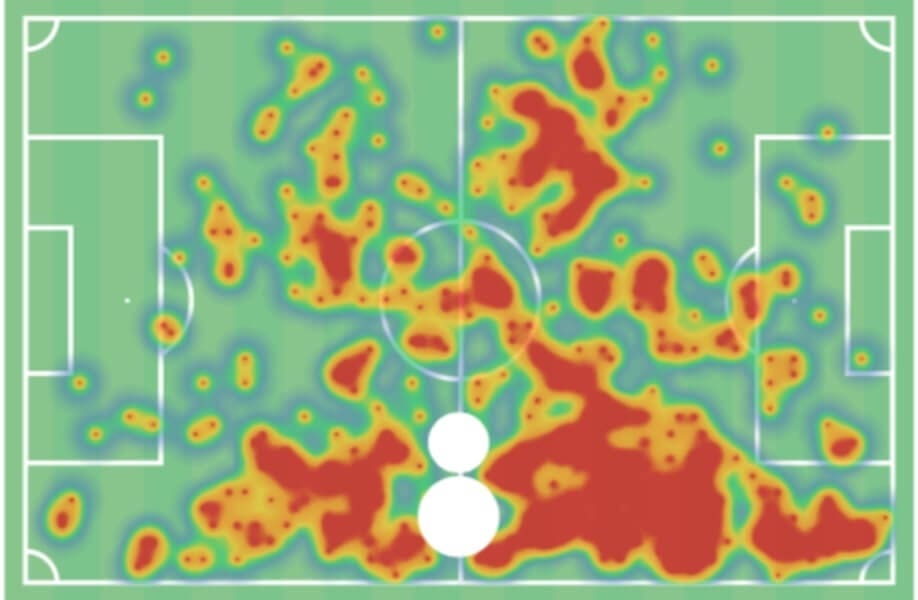
After making his debut as Southampton’s left attacking midfielder (number ‘10’), Smallbone has mostly been featured as the right ‘10’ in their 4-2-2-2 formation since then. No wonder the heatmap shows that the youngster has a greater influence on the right side of the field. Having said that, the 20-year old has also, at times, started as a defensive central-midfielder, which is his natural position, as we have seen in most of his U23 games.
When Smallbone plays in a more attacking position, he likes to become a creative outlet in the attacking third and get into the box whenever possible. On the other hand, when he plays as a defensive central midfielder, he provides a screen to the defensive line and helps in effective vertical ball progression. Hence, Smallbone is a multi-dimensional player who likes to get involved in the offensive as well as the defensive side of the game, which is also evident from his presence across all the thirds in the heatmap.
Such a box-to-box playing style demands a high level of work-rate and Smallbone has, so far, displayed that he has the steel to work tirelessly throughout a game. It is also one of the essential requirements in the Hasenhüttl system. A couple of following figures epitomizes the Smallbone’s work-rate.
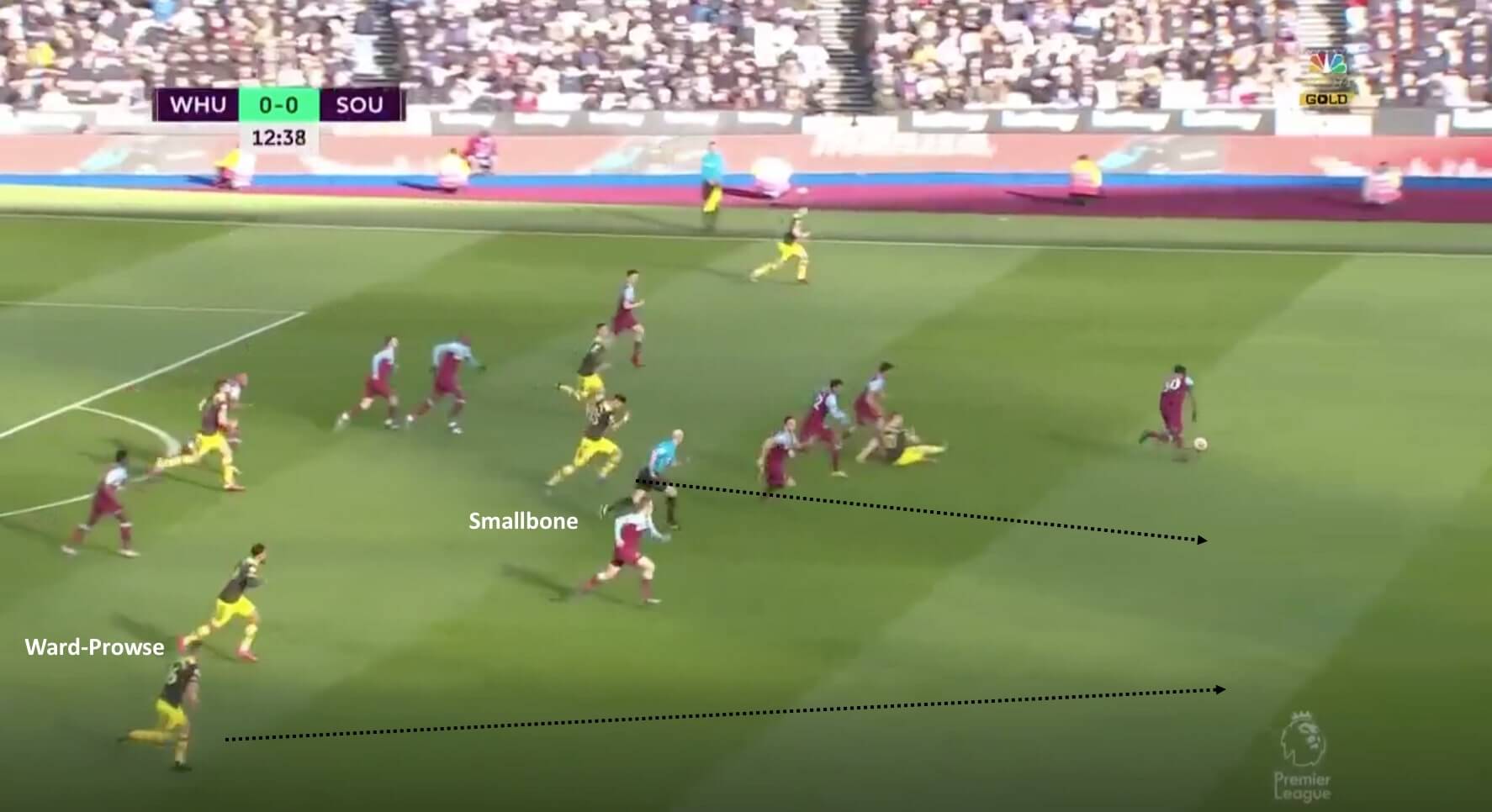
The figure shows a moment where West Ham United are forming a dangerous counter-attack in transition after a Southampton corner. Notice Smallbone’s position behind the West Ham players as the youngster strives to get into a defensive position.
As the home side entered Southampton’s penalty box, only Smallbone and Ward-Prowse continued their run into the 18-yard box. While the youngster covered the remaining two attackers to force the man in possession to take a shot from the half-space, the latter made an important sliding tackle to deny a goal to West Ham, which is shown in the following figure.
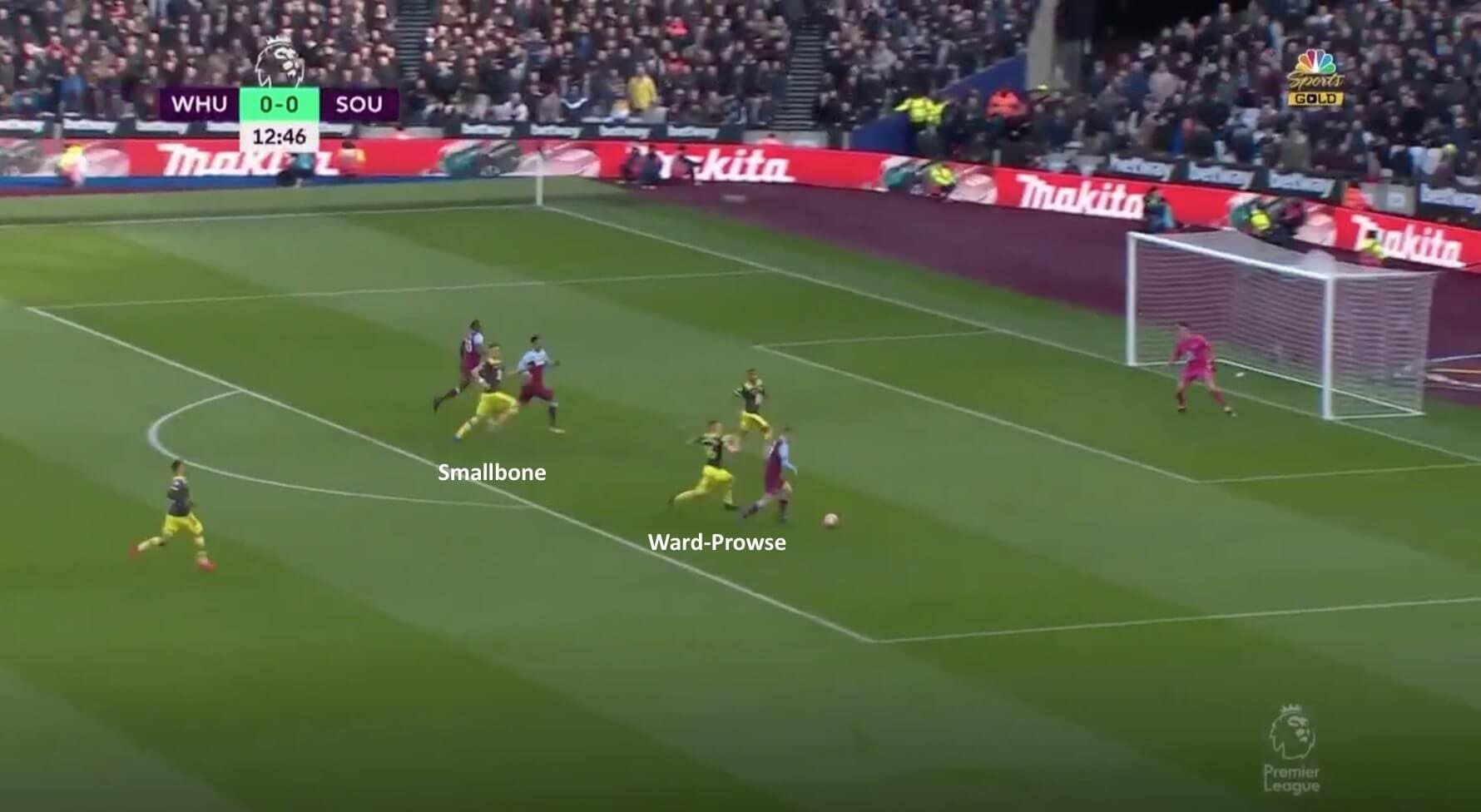
One of Hasenhüttl’s principles of play is to aggressively press an opponent higher up the pitch to win possession in the attacking half. Southampton press either as a consequence of certain pressing triggers during an opposition buildup or during a counter-pressing situation when the Saints lose the ball in the opposition half. Their pressing intensity (PPDA) metric of 9.79 (fifth-lowest in the league) indicates the intensity of their press.
This kind of pressing structure requires the players to have a high level of anticipation and aggression that can effectively enable the team to win possession in the opposition half. Smallbone’s aggressive pressing in the opposition half and high game awareness naturally adapts himself to this tactic, which is one of the reasons why the 20-year old has been featured often since making his debut. The following figure shows an instance of Smallbone’s high pressing action against Watford.
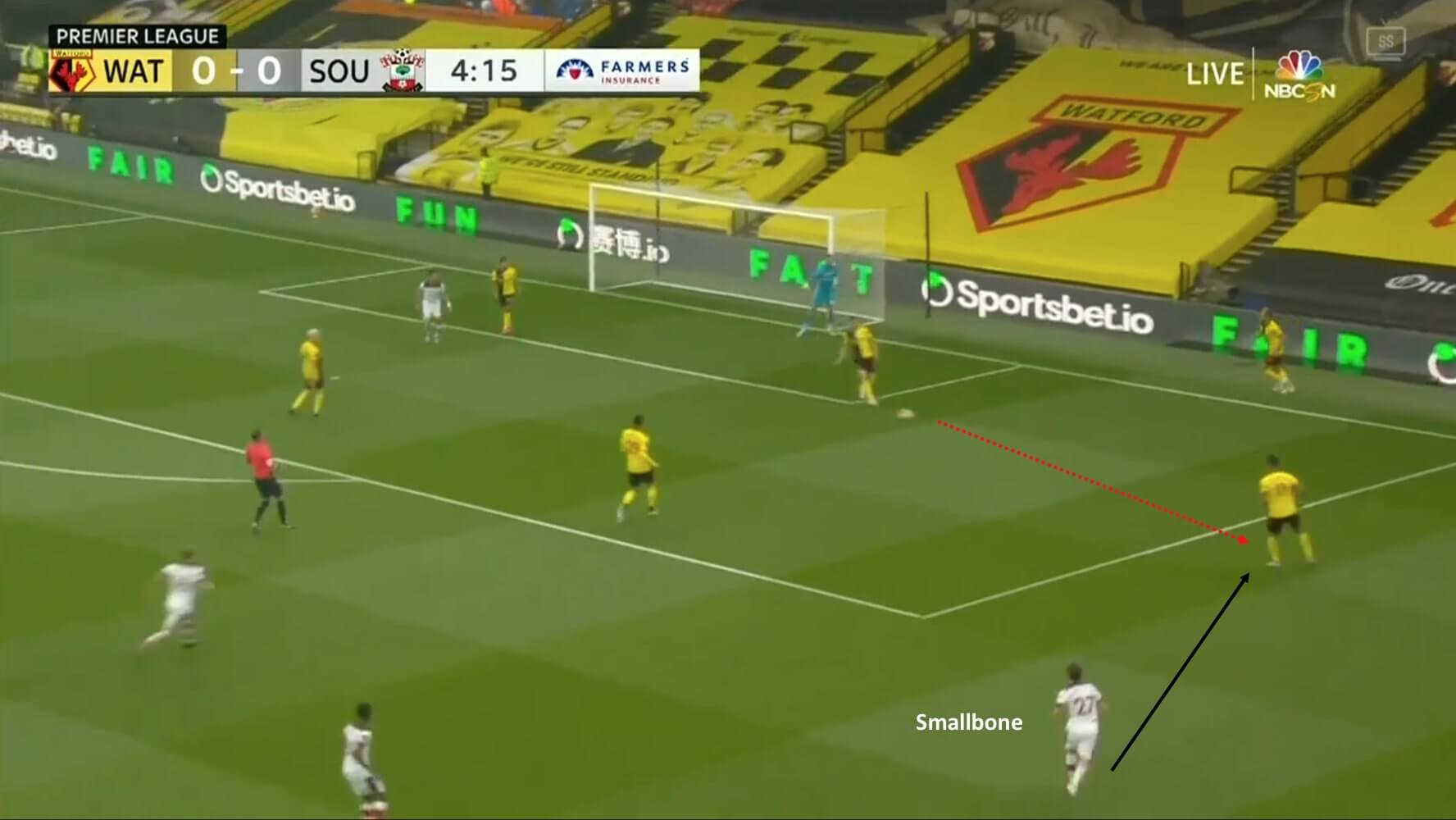
A few seconds before the image was captured, Danny Ings lost the ball in the Watford box. Moments later, as the Watford center-back attempted a pass to their wide-midfielder, Smallbone anticipated the move and timed his run early to press the midfielder and forced him to go long in turn winning a turnover for his side in the Watford half.
Out of the Smallbone’s 5.1 total recoveries per 90 minutes during the previous season, 3.46 had been a consequence of a counter-pressing action, which constitutes to 67.84%. The 20-year old also made 2.37 recoveries in the final third, which was one of the best figures amongst the other field players in the league. The following recoveries map of Smallbone provides a visual representation of the mentioned figures.
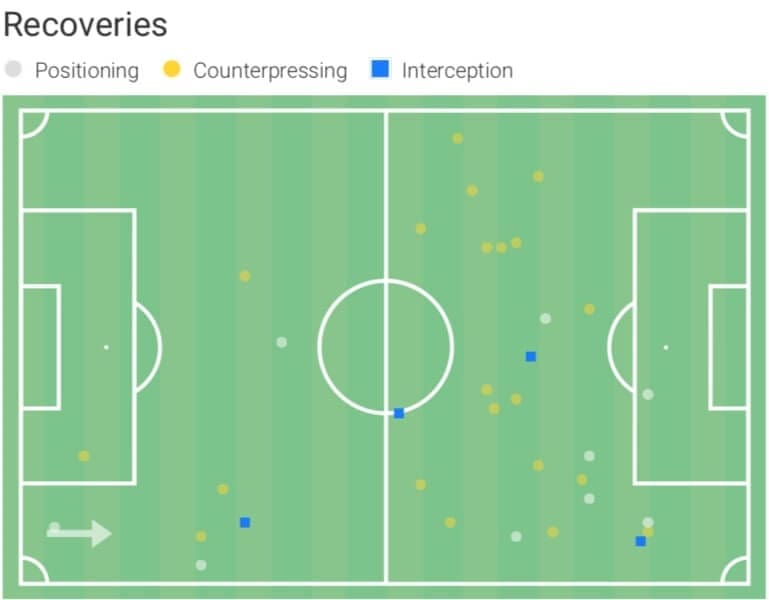
Spatial awareness
The most remarkable attribute of Smallbone that stands out from other young players of his age group is his ability to recognize spaces all over the field. Being merely 20 years old, he has an impressive level of game awareness and intelligence that allows him to occupy significant attacking and defensive positions. In this section, we will see a series of in-game examples that will show his spatial intelligence spanning across both halves.
Let us start by highlighting Smallbone’s spatial intelligence in the defensive half. When he plays as a defensive midfielder, he provides an effective ball progression route for his team as he constantly makes smart movements ahead of the defensive line to pop into spaces so that he can become a viable passing option. The following figure shows one of its instances.
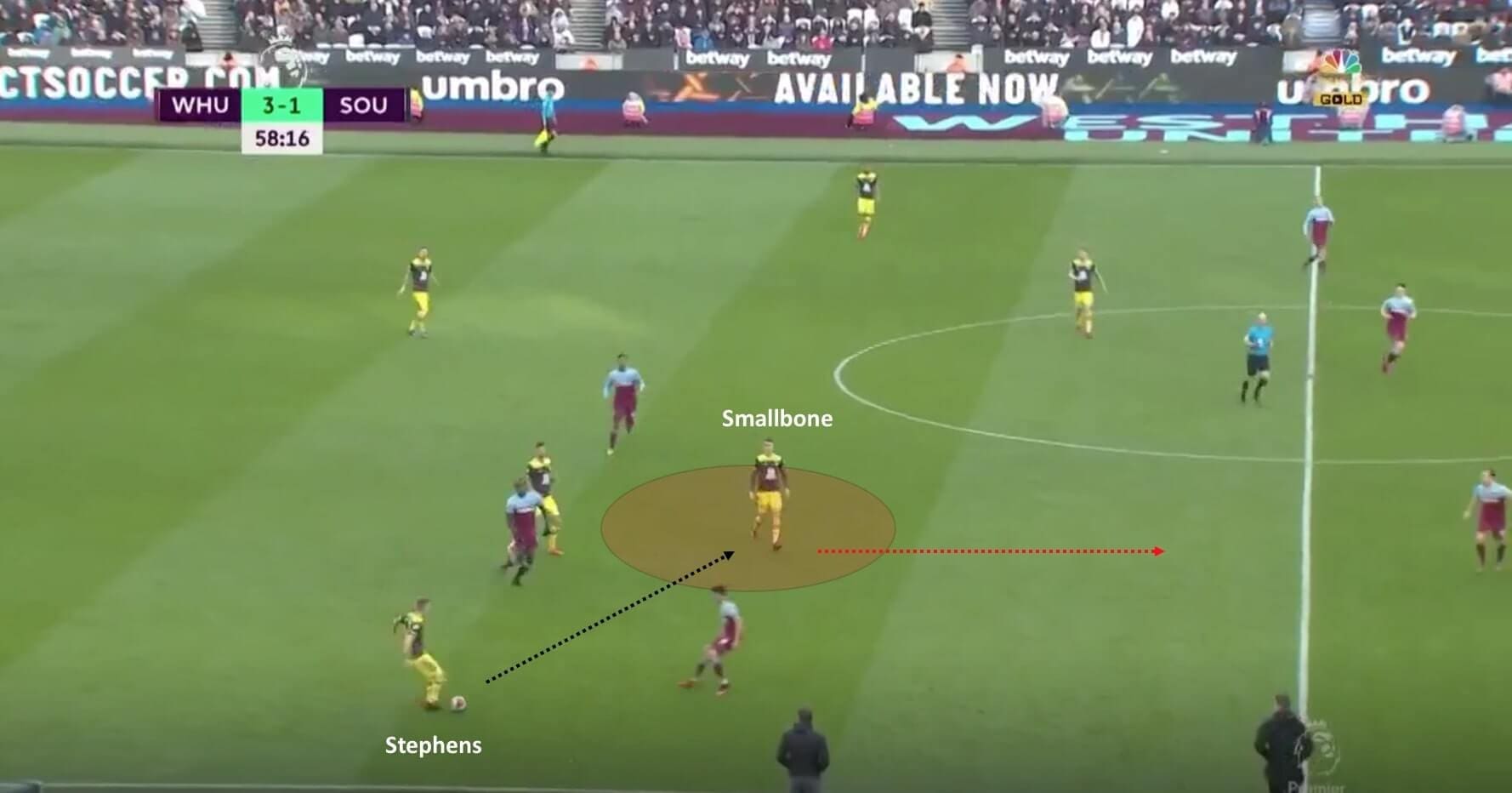
Moments before the image was captured, Smallbone was positioned centrally when Jack Stephens (man in possession) received the ball. As the two West Ham players started to press Stephens, Smallbone recognized a pocket of space forming at the edge of the middle third. Hence, the youngster immediately made a horizontal movement in the space to get past his marker and provide passing support for Stephens. As soon as he received possession, the 20-year old had ample space ahead of him to progress the ball vertically.
While the above figure provided an example of a lateral movement, the youngster also tends to drop deep often from the higher areas of the field to provide passing support.
Smallbone’s occupation of space in his half also allows him to make intelligent defensive movements to cover important spaces in the backline to prevent an opposition to exploit them. An example is shown in the following figure.
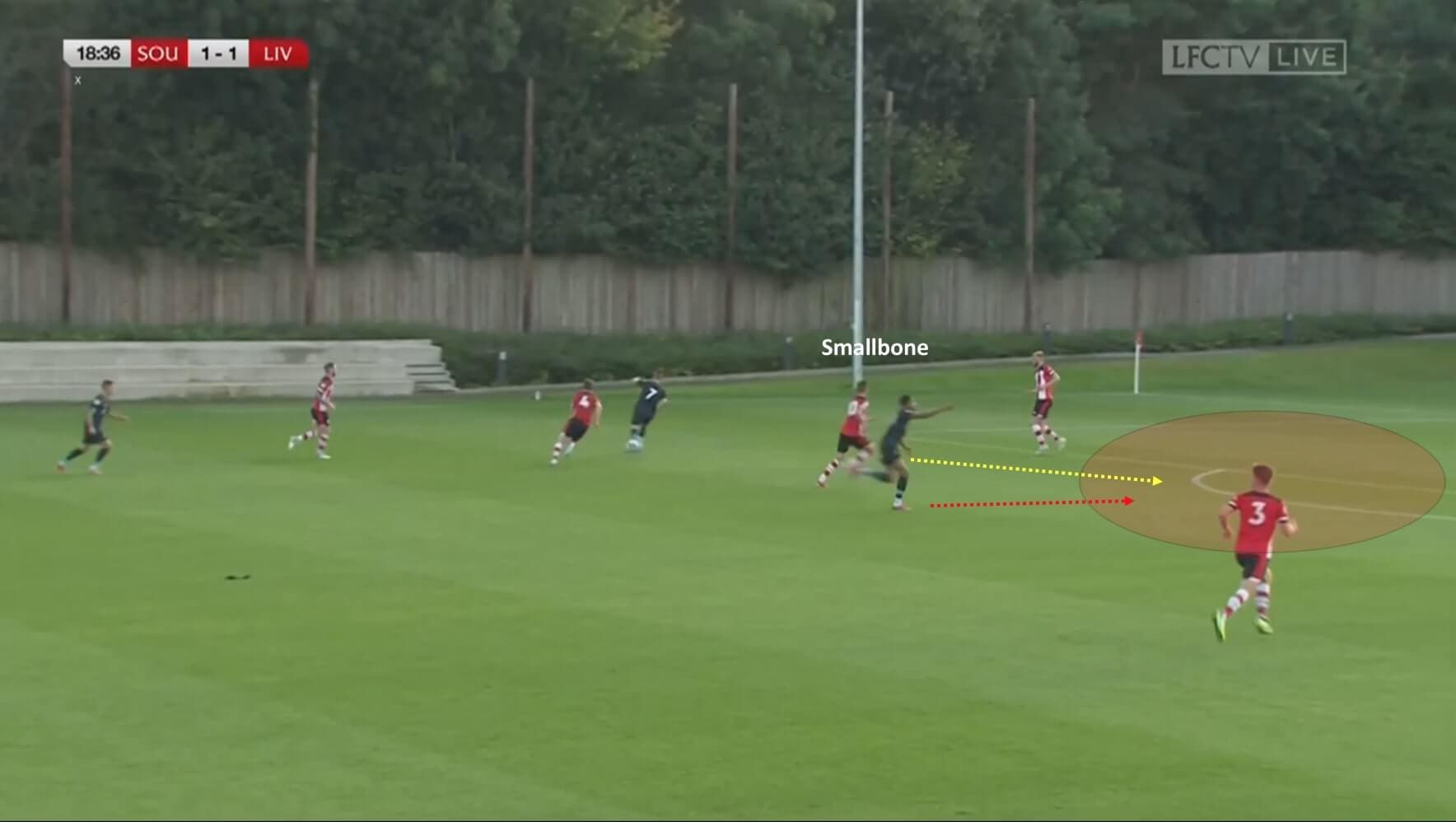
This image shows an example of a U23 game against Liverpool where the decision of Southampton’s right center-back (number ‘4’) to press the opposition man in possession has created a huge gap between the left center-back and the right full-back. Playing just ahead of the defensive line, Smallbone recognized the gap and made a quick run inside the box to cover the space before a Liverpool attacker, who is making a marauding forward run, can expose the space.
Smallbone’s ability to find spaces is not limited to the defensive half. The youngster is also impressive in identifying pockets of space in the opposition half as well, as the couple of following figures illustrates.
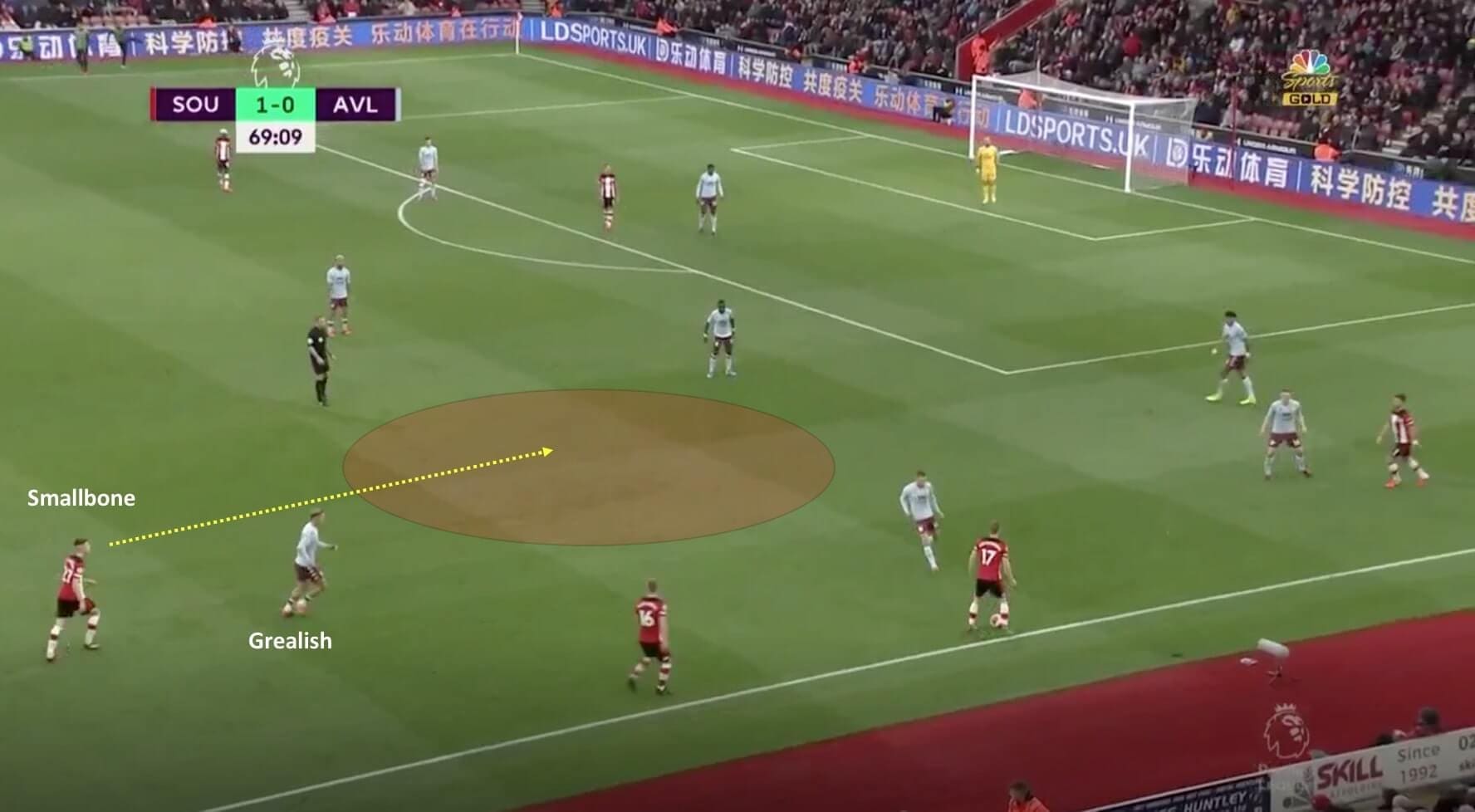
In the above figure, as the wide players of Aston Villa made movements towards the flank to limit Southampton’s attack, the central players stayed static, resulting in the creation of space in the right inside-channel (half-space). Smallbone quickly recognized the space and made a run from behind Jack Grealish to occupy the space and create an attacking opportunity for his side.
While the above figure shows his run into the half-space, the following figure shows Smallbone making an outside run on the right flank between the opposition’s defensive and midfield lines.
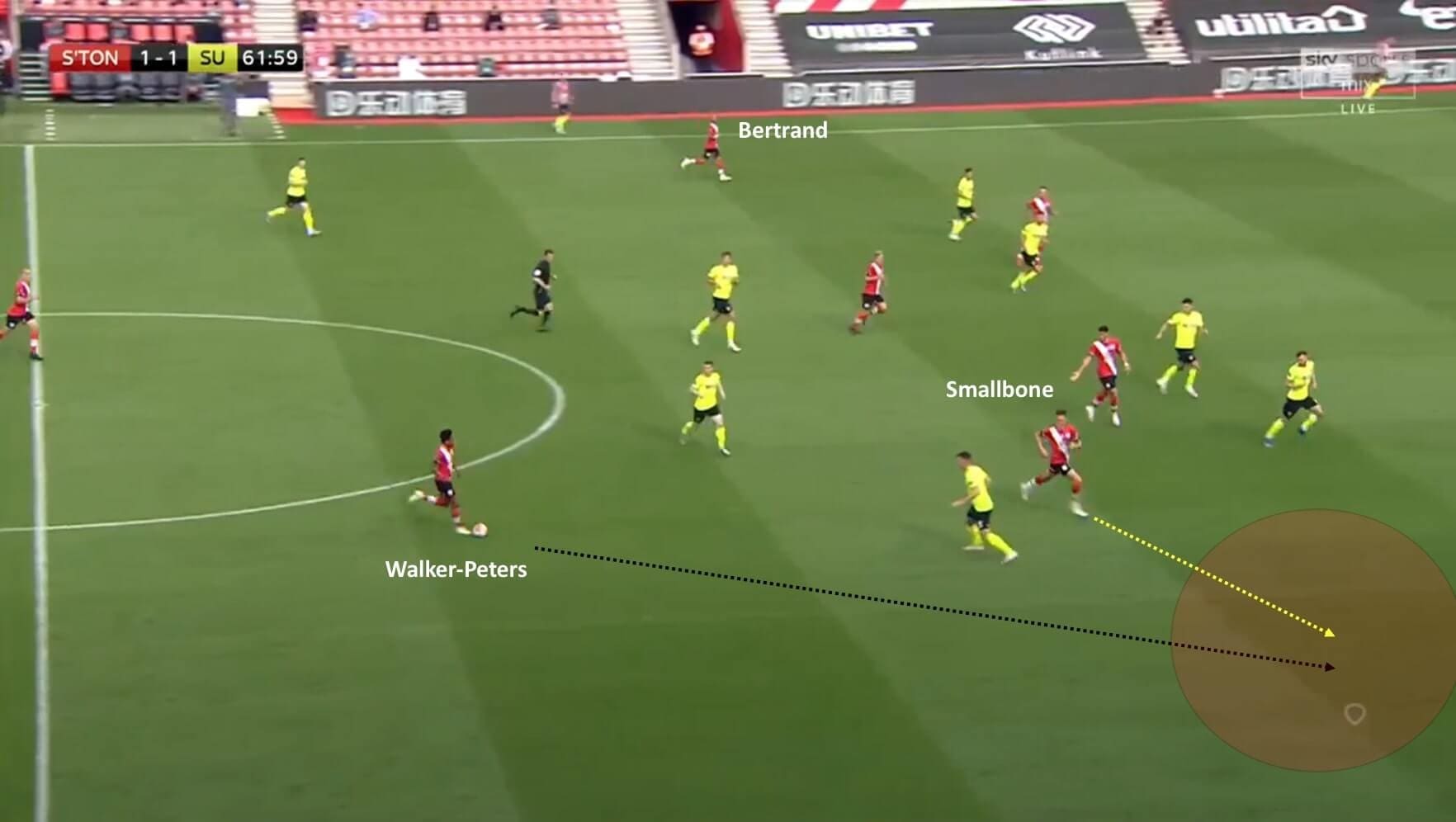
The image shows a moment where Southampton were forming an attack in transition. As Sheffield United had congested the central space by compressing their defensive and midfield lines, it had opened up spaces in the wide areas. As Kyle Walker-Peters, who is responsible for providing the width on the right, was more central with the ball, the right-back’s only feasible passing option was the ex-Chelsea man Ryan Bertrand on the left flank. However, Smallbone quickly made a run into the vacant space in the right channel to provide a better passing option to Walker-Peters as a pass to the left-back would have more risk of a turnover or loss of possession.
Occupation of space is one of the biggest strengths of Smallbone. His reading of the game allows him to make shrewd movements across the field, may it be between the lines, on the flanks, in either of the inside channels, inside the box, or in his half.
Technical abilities
Smallbone is a technically sounds player who has shown quality vision, passing ability, and range, as well as a smooth first-touch. When a player is good at arriving in spaces (which Smallbone is as seen in the previous section) and then has a high level of technical ability to back it up, it makes him very productive in the offensive phase.
Let us try to start Smallbone’s technical analysis by showcasing his passing abilities. The youngster is a space investigator in true terms as he is not only good in terms of occupying free spaces but also has an eye for a pass into any available space, as shown in the following figure.
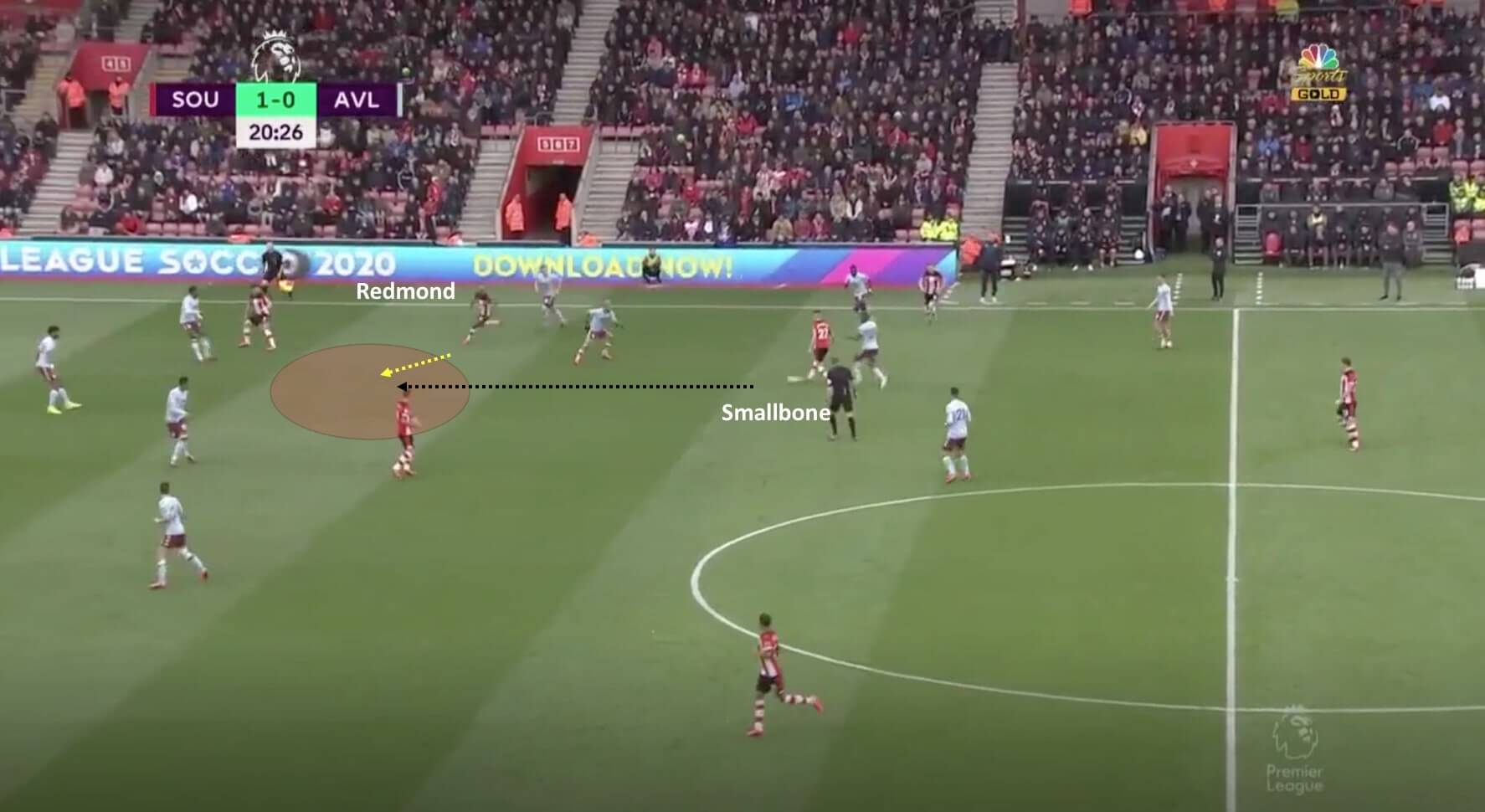
As Nathan Redmond started his run into a pocket of available space, Smallbone attempted a pass into space for the 26-year old midfielder. These kinds of passes are not easy, especially in the higher thirds as in addition to the vision, the precision of a pass also plays a big role when the opposition lines are compacted. In this case, for example, a slight under-hit of the pass could have been intercepted by the Aston Villa midfielder (marked in orange) and a slender over hit could have gone to the Villa defender (marked in yellow), forcing a possession turnover.
The vision to recognize the pass and then to execute it to perfection exemplifies the passing ability of the 20-year old. Smallbone’s pass puts his team in a dangerous attacking position as Redmond receives the ball while diagonally facing the goal. Hence, he can put balls in the attacking channels, where Southampton attackers can make runs beyond the Villa backline.
Smallbone prefers short to medium passes as 76.67% of his progressive passes are between 0-30 m. Having said that, the youngster is not afraid to attempt a long pass for switching the play or vertically progressing the ball. In fact, he was often seen to make these kinds of passes in his U23 games, as he was responsible for delivering the set-pieces. The following example shows his broad passing range as he switches the play with a perfect pass after finding himself with the ball into a space in the attacking third.
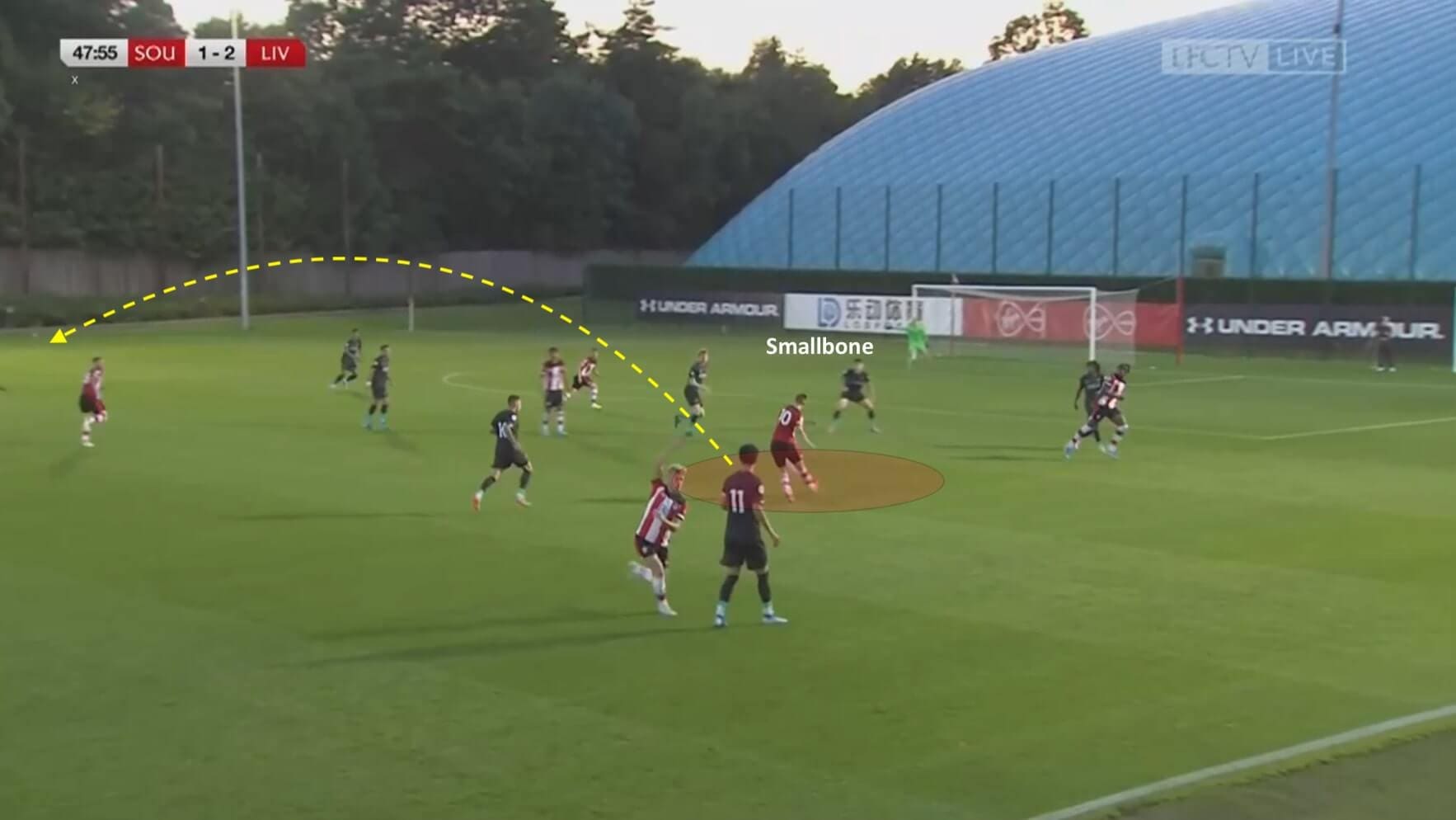
Apart from passing ability, Smallbone also has an impressive first-touch that allows him to effectively play in tight spaces. The following figure shows an example where he receives a heavy pass from his teammate. Smallbone’s first touch allows him to quickly control the ball as well his body shape and evade the pressure from one of the opposition midfielders to make a successful pass to the number ‘23’.
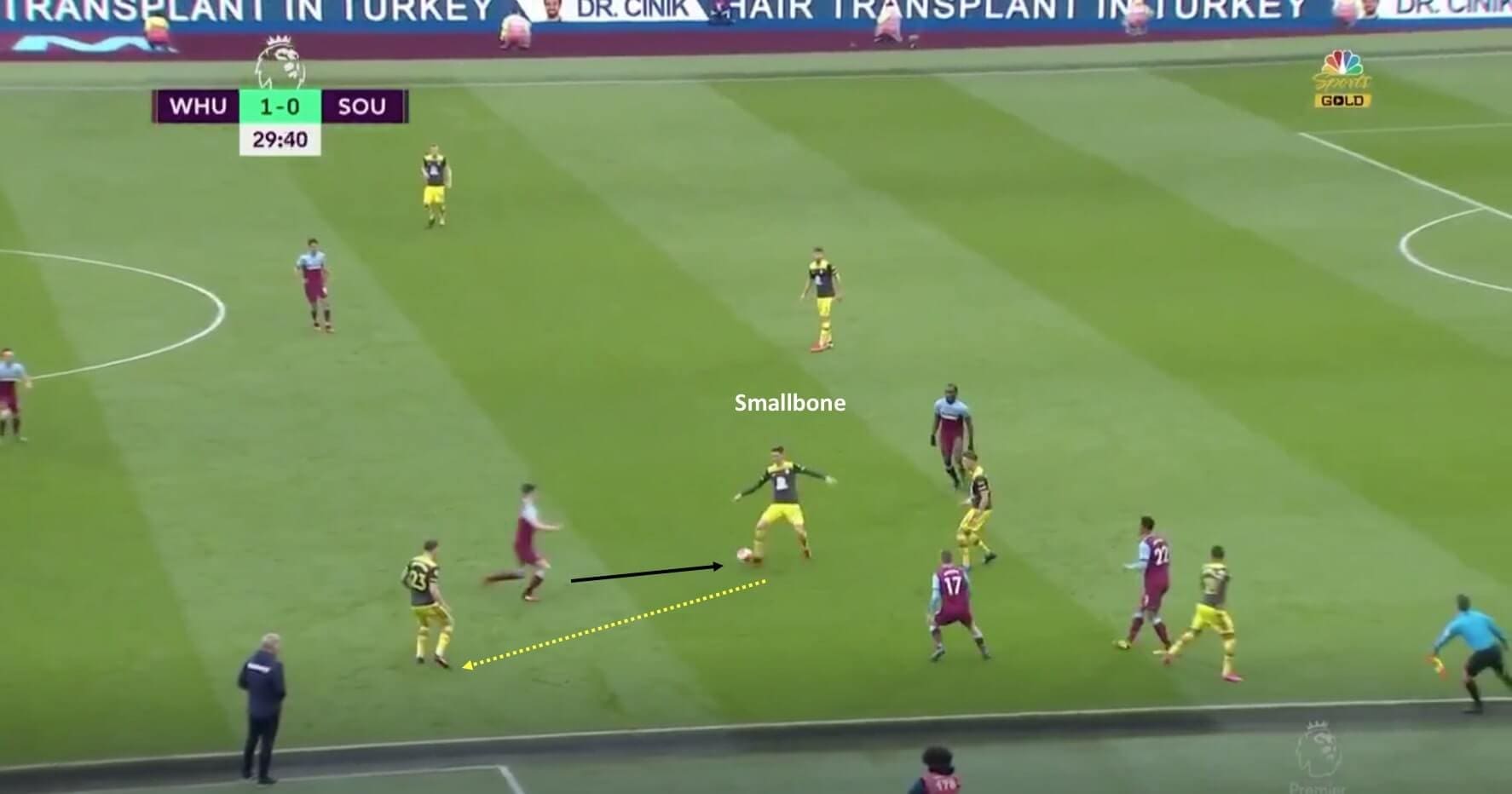
Smallbone is a technically gifted midfielder who can be a great asset in effective ball progression through thirds. He possesses the creative element in him and with his ability on the ball and passing range, he can quickly penetrate the opposition lines. However, the midfielder seldom takes risks during possession and selects a “safer” passing option more often than not, which is something that he needs to improve. While it is not the worst thing as it helps him to avoid making errors in the deeper areas, it often hampers ball progression, especially in attacking transitions, consequently limiting the team’s attacking output. The following in-game scenario explains the point.
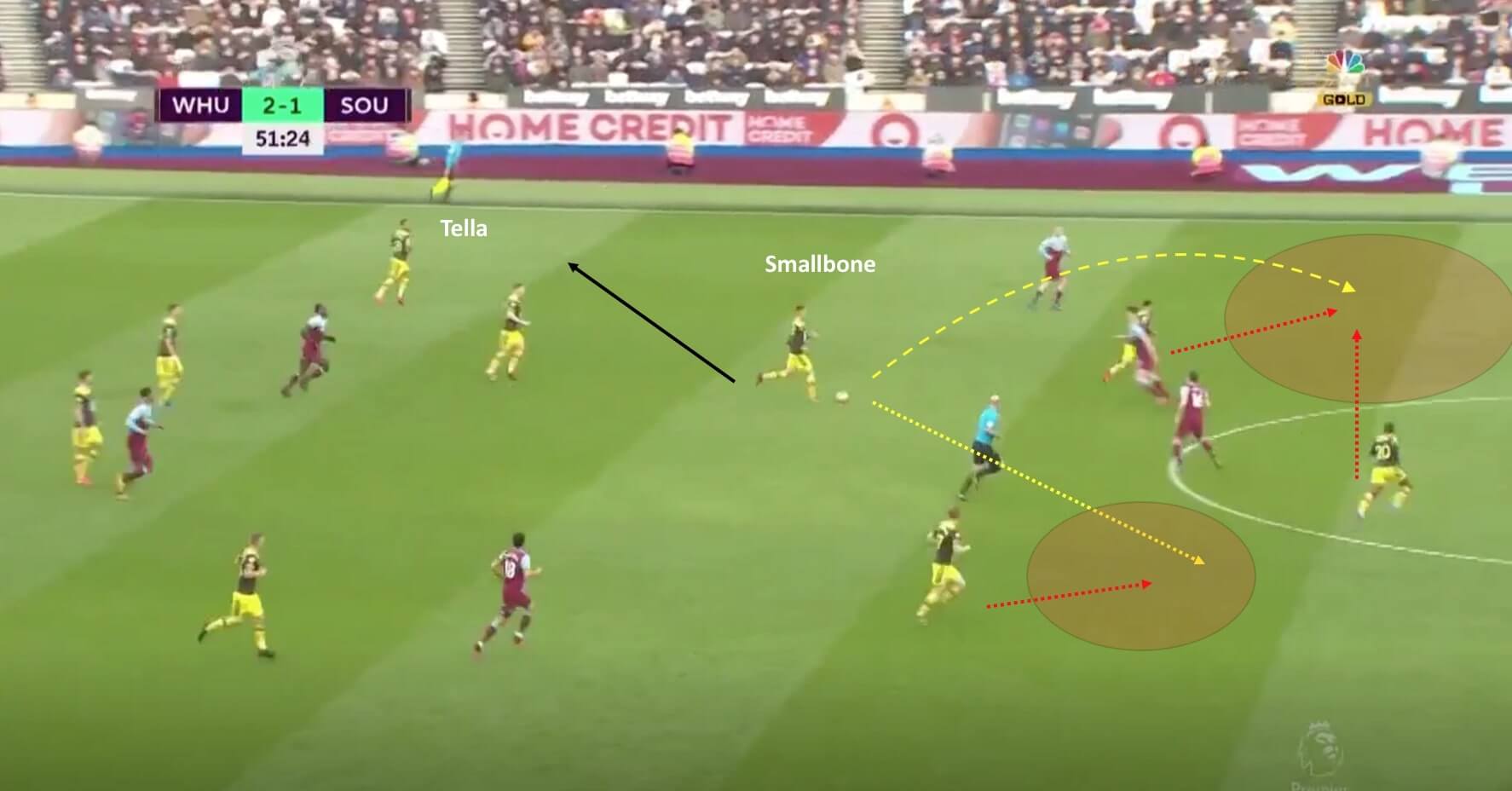
As Smallbone received the ball in the space between the opposition’s first and second lines of pressure during a Southampton counter-attack, he had attackers ahead of him who were making dangerous runs between the opposition lines. Smallbone was facing the opposition goal which meant that a dink over the midfield line or a diagonal through ball to Stuart Armstrong on the right would have isolated the Southampton attackers against the West Ham backline for a possible goal-scoring opportunity. However, the 20-year old chose to pass the ball back to Tella, consequently allowing the opposition to regroup and kill the counter-attack.
Smallbone’s reluctance to take risks in possession can also be seen in his ball progression style. While the 20-year old makes 4.28 progressive passes per 90 minutes, he makes merely 0.49 progressive runs, which is also represented in the following ball progression map of the youngster.
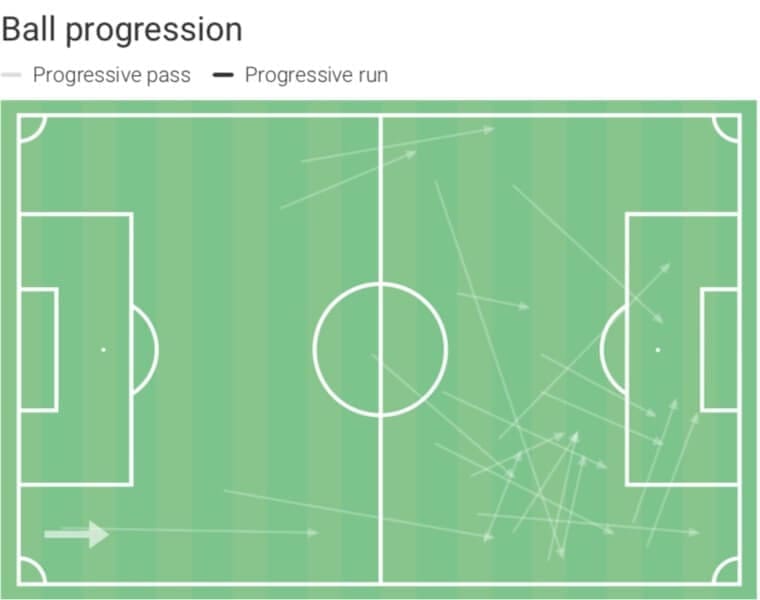
Lack of aggression in the defensive third
Hasenhüttl was critical about Smallbone’s lack of aggression off the ball in one of his post-match interviews. While the 20-year old has an aggressive pressing style in the opposition half, as we have seen earlier, he seldom replicates it in his half.
While it is important for a player to not be excessively aggressive in the defensive third as it can lead to giving away dangerous spot-kicks from in and around the box to the opposition, Smallbone comes out as very passive at times. The 20-year old is often weak in challenges and duels in his half which can lead to a potential goal-scoring chance for an opposition. One of its instances is shown in the following figure.
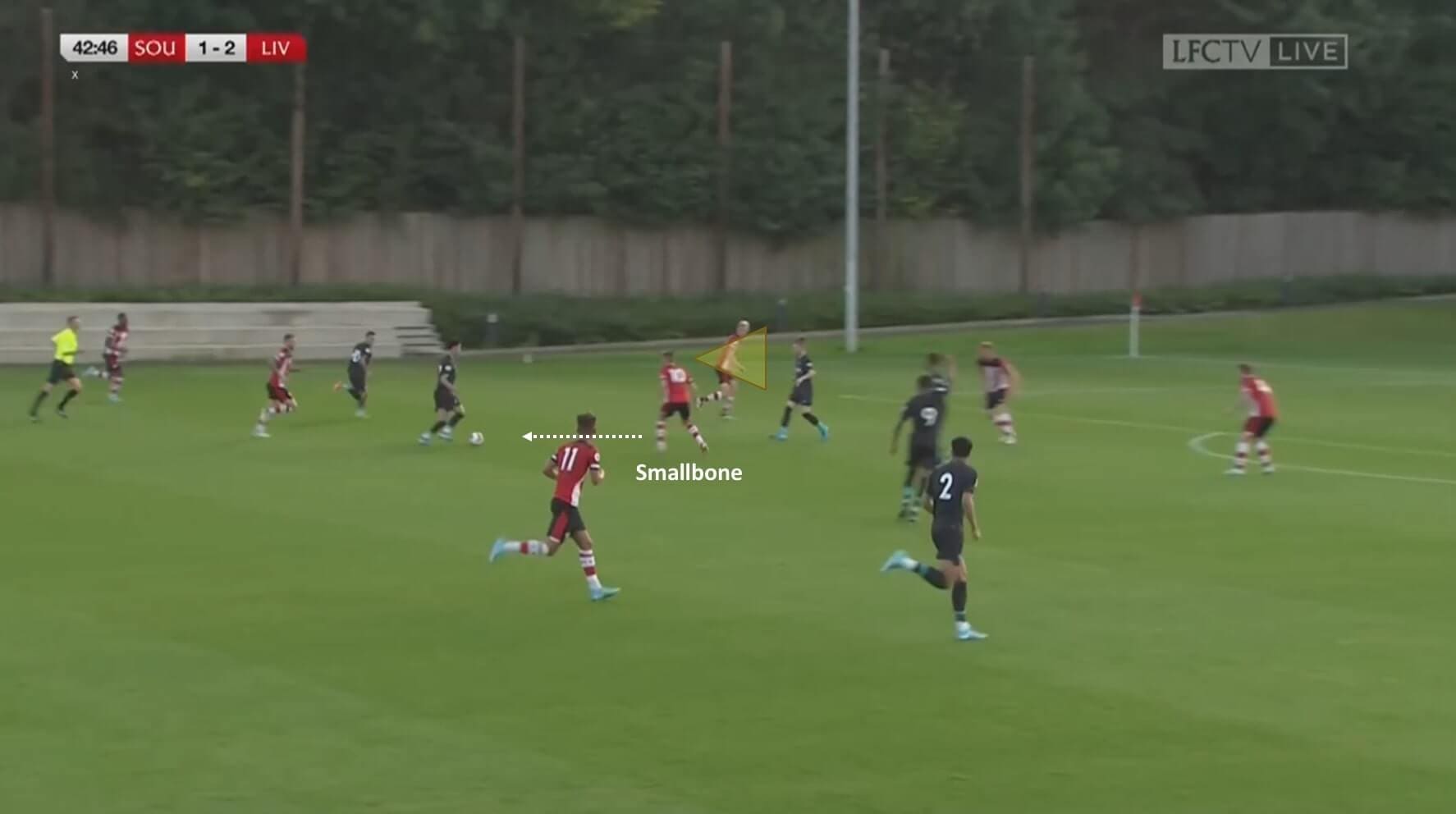
As the U23 side of Liverpool progressed in the attacking third, Smallbone found himself against the man in possession. As a defensive midfielder, the best action could have been to press the Liverpool player with the ball while cover shadowing the other attacker. However, Smallbone retreated towards the defensive line, giving easy space to the ball carrier just outside the box.
Conclusion
“Will is a young man who is part of the future of this football club,” said Hasenhüttl. “He has made some big steps this season, and he is someone who has a lot of potential to continue to grow as a player.”
Smallbone’s excellent reading of the game and spatial awareness, combined with the passing range and ability makes him an effective player all over the pitch. Even though the 20-year old has physical shortcomings, he shows an imposing level of maturity. Hence, our observation about the youngster seconds the Austrian manager’s feedback about the player.
Fortunately, Smallbone is at the right club and under the right manager whose tactics can unleash his potential to the best possible limits. Overall, Smallbone’s analysis suggests that he is an exciting young player and if he can overcome his shortcomings, he can make a big step in the first XI during the ongoing season.

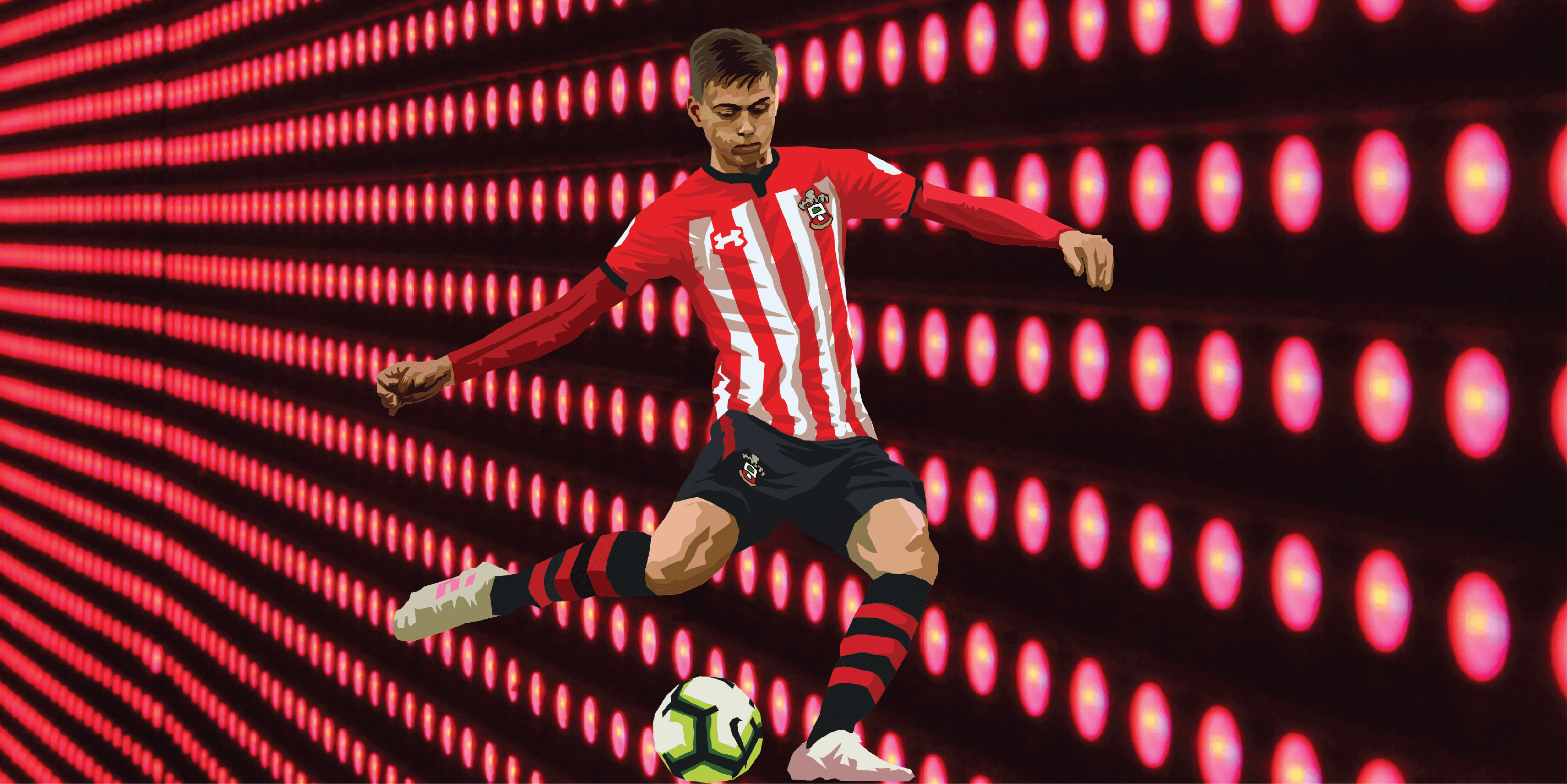



Comments